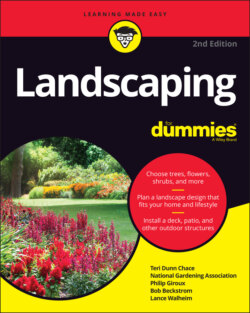Читать книгу Landscaping For Dummies - Lance Walheim - Страница 90
About wood
ОглавлениеAll wood is not created equal. Only certain grades (called heart grades) of certain species (cedar, redwood, cypress, and some tropical woods) are naturally resistant to decay. Many nondurable woods, such as pine and Douglas fir, aren’t decay resistant, but they are available as pressure-treated with preservatives and stains. They’re treated for either aboveground use or for ground contact.
Here are some general tips to bear in mind when looking at wood for your projects:
Consider strength. These requirements vary depending on whether you’re considering a deck (that needs to support furniture, perhaps a grill, and a number of people at times) or a structure such as a pergola, arch, or fence that will only support the growth of a vine. Southern pine, Douglas fir, and cypress are stronger than redwood, cedar, and other pines. Black locust is becoming more popular and larch, where available, may be suitable. In recent years, there has been a disheartening decline in lumber quality as tree plantations grow the wood too fast and/or harvest it too young, resulting in reduced strength and durability.
Inspect your potential purchases for flaws. Sight along a board looking for warping and twisting. Knots are okay if tight and in-grown, whereas loose ones are a bad sign.
Pay attention to size. The thickness and width of boards are expressed in nominal dimensions, such as 2x4 or 1x6, but the actual dimensions are less: ½- to ¾-inch (.5 to 1.9 cm) less (a 2x4, for example, is 1½ by 3½ inches, or 3.8 by 8.9 cm). For length, boards come in 2-foot (.6 m) increments from 6 to 20 feet (1.8 to 6.1 m).
Be selective with the type. Choose boards with a high percentage of heartwood (the darker, richer-colored wood) and dense growth rings (at least eight per inch/2.5 cm). In addition, remember the following:Some woods, such as the heartwood of cedar and redwood, resist decay naturally. These woods also tend not to warp as much as other species. Although cedar and redwood lack strength for major load-bearing members, such as deck joists, they work well for fences.Nondurable woods (southern pine and Douglas fir, for example) that have been pressure-treated with preservatives make good fence materials. Bear in mind that treated lumber fencing really shouldn’t be used adjacent to edible plants (or used to make raised beds for food gardening — see Chapter 10), because the chemicals do leach into the soil over time. You can improve the appearance of most wood by staining or painting it, so consider durability and strength first.
